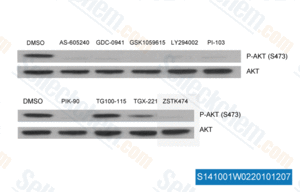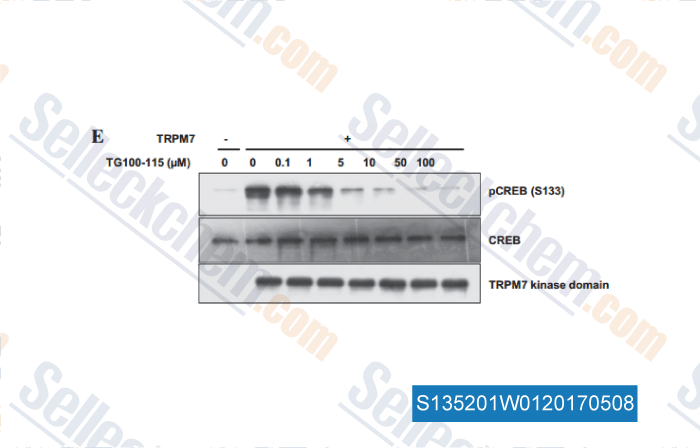|
How to Cite 1. For In-Text Citation (Materials & Methods): 2. For Key Resources Table: |
||
|
Toll Free: (877) 796-6397 -- USA and Canada only -- |
Fax: +1-832-582-8590 Orders: +1-832-582-8158 |
Tech Support: +1-832-582-8158 Ext:3 Please provide your Order Number in the email. We strive to reply to |
Technical Data
| Formula | C18H14N6O2 |
||||||||||
| Molecular Weight | 346.34 | CAS No. | 677297-51-7 | ||||||||
| Solubility (25°C)* | In vitro | DMSO | 9 mg/mL (25.98 mM) | ||||||||
| Water | Insoluble | ||||||||||
| Ethanol | Insoluble | ||||||||||
| In vivo (Add solvents to the product individually and in order) |
|
||||||||||
|
* <1 mg/ml means slightly soluble or insoluble. * Please note that Selleck tests the solubility of all compounds in-house, and the actual solubility may differ slightly from published values. This is normal and is due to slight batch-to-batch variations. * Room temperature shipping (Stability testing shows this product can be shipped without any cooling measures.) |
|||||||||||
Preparing Stock Solutions
Biological Activity
| Description | TG100-115 is a PI3Kγ/δ inhibitor with IC50 of 83 nM/235 nM, with little effect on PI3Kα/β. Phase 1/2. | ||||||||
|---|---|---|---|---|---|---|---|---|---|
| Targets |
|
||||||||
| In vitro | TG100-115 inhibits PI3Kγ and -δ, with IC50 of 83 and 235 nM, respectively. This compound is not active for PI3Kα and -β, with IC50 of 1.2 and 1.3 mM. In human umbilical vein endothelial cells (HUVECs), this chemical (up to 10 μM) has no effects on cell proliferation and VEGF-stimulated ERK phosphorylation. However, it (10 μM) interrupts other VEGF signaling pathways, such as those that culminate in VE-cadherin phosphorylation. [1] In HUVECs, this compound (10 μM) inhibits the VEGF-induced increase of total level of VE-cadherin. It inhibits VEGF mediated phosphorylation of mTOR and p70S6 kinase, both of which are downstream of PI3K. This chemical (125 nM to 10 μM) also inhibits FGF-stimulated phosphorylation of Akt. [2] | ||||||||
| In vivo | In Miles assay models, TG100-115 (1-5 mg/kg) reduces edema formation and inflammation in rats. In rigorous rodent and porcine models of myocardial ischemia (MI), this compound (0.5-5 mg/kg) provides potent cardioprotection, limits infarct development, and preserves myocardial function. [1] In mice, this chemical (5 mg/kg) markedly diminishes vascular permeability (VP) in response to either Sema3A or VEGF, indicating that both factors may depend on PI3Kγ/δ to induce VP. [3] In a mouse asthma model, aerosolized TG100-115 markedly reduces the pulmonary eosinophilia, inhibits interleukin-13 and mucin accumulation. [4] | ||||||||
| Features | A potent and dual selective PI3Kγ/δ inhibitor. |
Protocol (from reference)
| Kinase Assay:[1] |
|
|---|---|
| Cell Assay:[1] |
|
| Animal Study:[1] |
|
References
|
Customer Product Validation

-
, , Saraswati Sukumar of Johns Hopkins University School of Medicine

-
Data from [ , , Biochim Biophys Acta, 2017, 1861(4):947-957 ]
Selleck's TG100-115 Has Been Cited by 16 Publications
| PI3Kγ inhibition combined with DNA vaccination unleashes a B-cell-dependent antitumor immunity that hampers pancreatic cancer [ J Exp Clin Cancer Res, 2024, 43(1):157] | PubMed: 38824552 |
| Inactivation of TRPM7 Kinase Targets AKT Signaling and Cyclooxygenase-2 Expression in Human CML Cells [ Function (Oxf), 2023, 4(6):zqad053] | PubMed: 37786778 |
| Inactivation of TRPM7 Kinase Targets AKT Signaling and Cyclooxygenase-2 Expression in Human CML Cells [ Function (Oxf), 2023, 4(6):zqad053] | PubMed: 37786778 |
| The molecular appearance of native TRPM7 channel complexes identified by high-resolution proteomics [ Elife, 2021, 10e68544] | PubMed: 34766907 |
| The FBW7-MCL-1 Axis Is Key in M1 and M2 Macrophage-Related Colon Cancer Cell Progression: Validating the Immunotherapeutic Value of Targeting PI3Kγ [ Exp Mol Med, 2020, 22] | PubMed: 32444799 |
| Simultaneous Control of Endogenous and User-Defined Genetic Pathways Using Unique ecDHFR Pharmacological Chaperones. [ Cell Chem Biol, 2020, 24 pii: S2451-9456(20)30080-5] | PubMed: 32330442 |
| TRPM7 Kinase Is Essential for Neutrophil Recruitment and Function via Regulation of Akt/mTOR Signaling [ Front Immunol, 2020, 11:606893] | PubMed: 33658993 |
| A facile and sensitive method of quantifying glutaminase binding to its inhibitor CB-839 in tissues [ J Genet Genomics, 2020, 47(7):389-395] | PubMed: 33004309 |
| Suppression of TRPM7 Enhances TRAIL-induced Apoptosis in Triple-Negative Breast Cancer Cells [ J Cell Physiol, 2020, 29] | PubMed: 32468675 |
| Inhibition of transient receptor potential melastatin 7 (TRPM7) protects against Schwann cell trans-dedifferentiation and proliferation during Wallerian degeneration [ Anim Cells Syst (Seoul), 2020, 24(4):189-196] | PubMed: 33029295 |
RETURN POLICY
Selleck Chemical’s Unconditional Return Policy ensures a smooth online shopping experience for our customers. If you are in any way unsatisfied with your purchase, you may return any item(s) within 7 days of receiving it. In the event of product quality issues, either protocol related or product related problems, you may return any item(s) within 365 days from the original purchase date. Please follow the instructions below when returning products.
SHIPPING AND STORAGE
Selleck products are transported at room temperature. If you receive the product at room temperature, please rest assured, the Selleck Quality Inspection Department has conducted experiments to verify that the normal temperature placement of one month will not affect the biological activity of powder products. After collecting, please store the product according to the requirements described in the datasheet. Most Selleck products are stable under the recommended conditions.
NOT FOR HUMAN, VETERINARY DIAGNOSTIC OR THERAPEUTIC USE.
